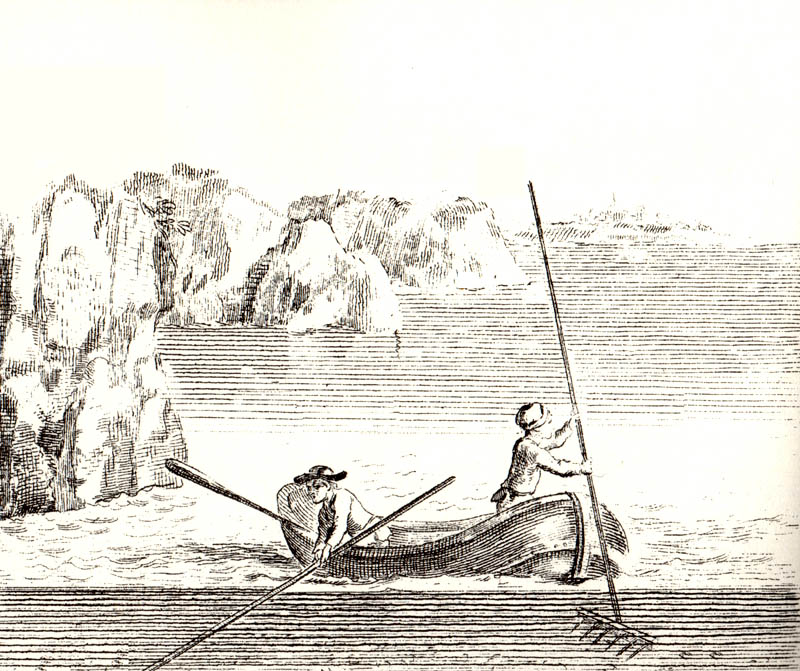
Men oystering with long rakes. From Diderot’s Encyclopedia (1763.)
Foodways refers to activities that deal with all aspects of food, including its procurement, preservation, storage, cooking and, finally, its disposal as refuse. The artifacts and features from the Daniels Homestead Site create a detailed mosaic of family foodways in 18th-century Waterford (then New London). The animal bone showed that beef (Bos taurus) was the most numerous and important of the livestock. Cattle provided beef and leather, and their horns were made into powder horns, cups and other receptacles. Beef was salted and stored in barrels, which preserved it for months. Cow milk was drunk or converted into butter and cheese, which were staples of the New England diet. This importance of cows is reflected in Thomas Daniels’s 1735 probate inventory, which lists “one cow and calf,” “one three year old heifer,” and “two cows and two calves.” Along with the cows and calves, Daniels had three “yoke of oxen,” which would have been used for plowing, harrowing, and hauling. Hannah Daniels also had “a cow and a calf” in her 1744 probate inventory. Pig (Sus sus) was the next most common livestock from the site, which provided pork, and like beef could be cut up salted and stored in barrels. Pork was also made into bacon by soaking it in saltpeter, salt and molasses and hanging it in a chimney flue for weeks. The bones of sheep (Ovis aries) or goat (Capra hicus) represent the third most common livestock from the site (the bones of these two animals cannot be easily distinguished below the skull). Along with numerous eggshell fragments, there were bones of domestic fowl including goose (Anser anser) and chicken (Gallus gallus). Along with their meat, geese provided down feathers for bedding and quills for writing.
The archaeological investigations indicate that hunting and fishing were also important activities at the Daniels site: wild game and fish made up about 9% of the household diet. Game animals include the New England cottontail (Sylvilagus spp), woodchuck (Marmota monax) and Eastern gray squirrel (Sciurus carolensis). In 18th-century Connecticut squirrel-hunting was a popular activity, and squirrel meat was served in a variety of ways: fried, in soups, and in pies. The largest game animal from the site was the white-tailed deer (Odocoileus virgianus). Turtle was also commonly eaten in the colonial period, and the remains of box turtle (Terrapene Carolina carolina) were also found. Wild bird species include the turkey (Meleagris gallopavo); however, by the 18th century domestic turkeys seem to have been common in Connecticut, according to the descriptions of various travelers. Other bird remains include the order Charadiiformes, which includes various shore birds, gulls and auks. Even small perching birds (Order Passeriformes), such as robins, jays, and thrushes, were eaten, often in pies. One method of catching small birds in New England included the use of “bird-lime,” which was a sticky substance spread on branches which trapped the birds when they perched. Bird-lime was made by boiling the juice of holly-bark, and then mixing it with oil or thin grease. Other evidence of hunting from the site includes numerous gunflints and small lead shot.

|
|
Men oystering with long rakes. From Diderot’s Encyclopedia (1763.) |
The Daniels homestead was close to streams, rivers and Long Island Sound; not surprisingly, fish were also a major
part of their diet and
included both freshwater species like the catfish (Family Ictaluridae), and bass (micropterus spp),
(includes largemouth and smallmouth bass) and saltwater species such as temperate bass (Morone spp), wrasses
(Family Labridae), and striped bass (Morone saxtilis). The largest fish from the site is the anadromous
sturgeon (Acipenser spp). Shellfish were also an important part of the Danielses' diet
and thousands of Eastern oysters (Crassostrea virginica), quahog (Mercenaria mercenaria) and other shellfish
remains were scattered outside of the house. The distribution of shellfish and
animal bone remains revealed several major
refuse dumping areas at the homestead, including right outside of the house.

|
Along with bone and shellfish, carbonized plant seeds and nuts reveal much about the foodways at the
Daniels Homestead. Among the most common remains found were tiny fragments of corn (Zea mays),
commonly called “Indian corn” in New England, beans (Phaseolus vulgaris), and the rind of a squash
(Cucurbita pepo). All three of these foods were adopted by the colonists from Native Americans.
Common Native dishes involved pounding or grounding dried corn into flour and then boiling it to make “samp.”
Corn was cooked with beans to make “succotash.” Dried corn was also toasted and made into "yokeag" or “nocake,” which made a
convenient food for travel. Other carbonized food remains from the site include a peach pit (Prunus persica) and an
apple seeds (Malus spp), which may have come from the Daniels’s own orchard.
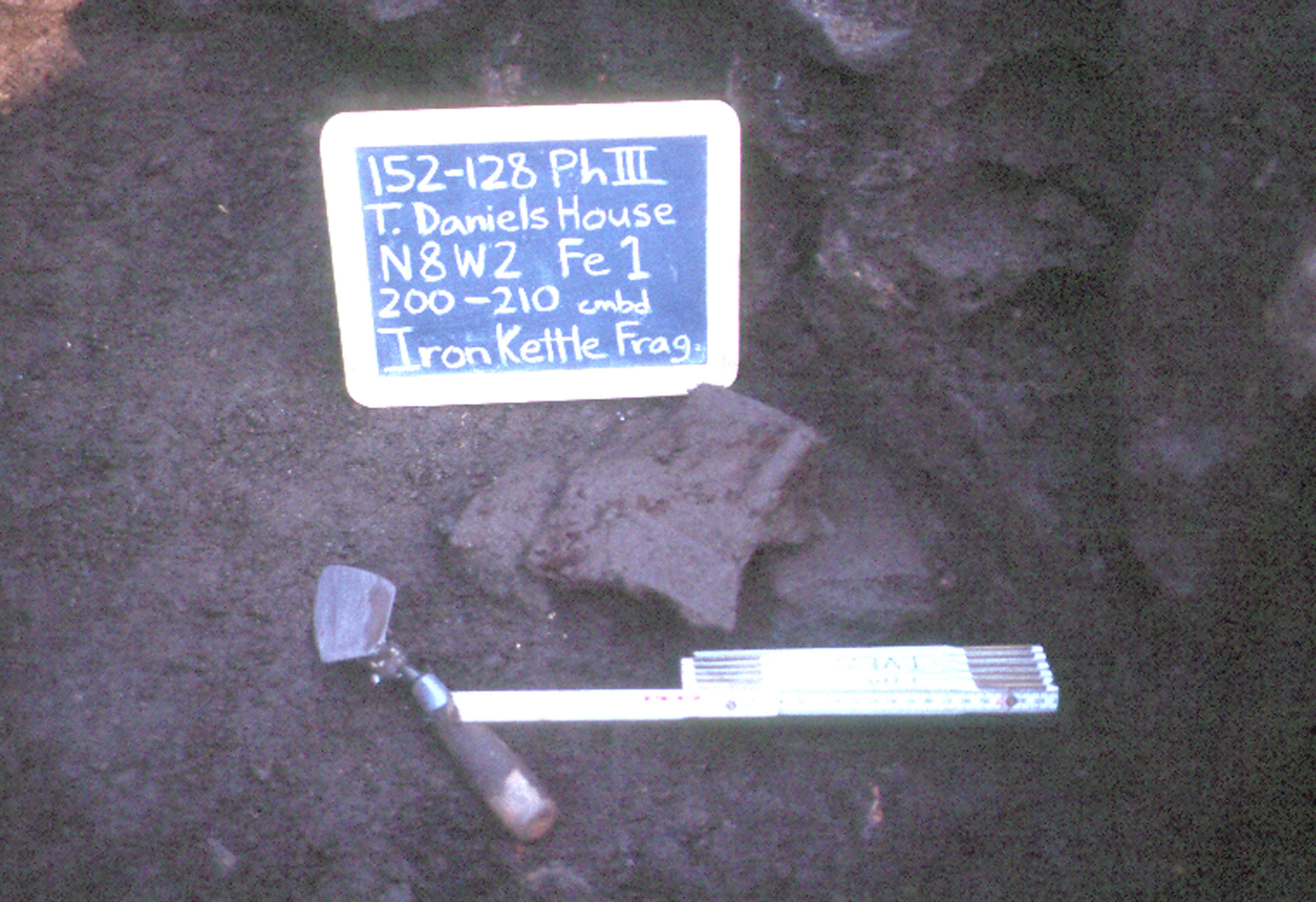
|
|
Iron pot found in the bottom of the cellar. |
Typical ways of preparing food in 18th-century New England included making various puddings, stews and pottages in large cast-iron kettles.
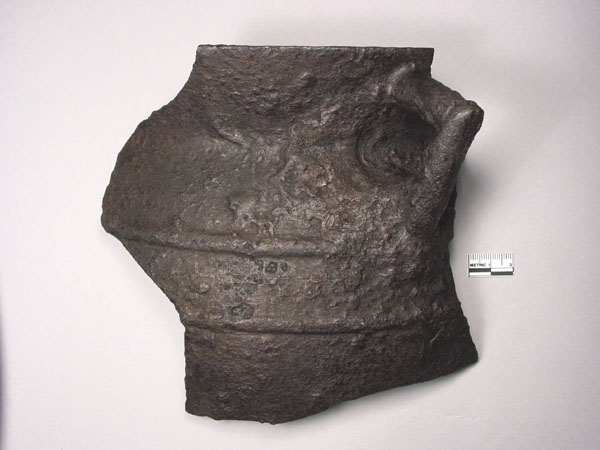
|
|
The iron pot after conservation. The rim diameter is 13 inches. Click to enlarge. |
Various types of fruit or meat pies were also baked in earthenware dishes and pans.
Tea-drinking became an important custom in Connecticut by the mid 18th century and sherds from three tea bowls,
four tea saucers, a possible creamer and teapot spout were recovered from the site.
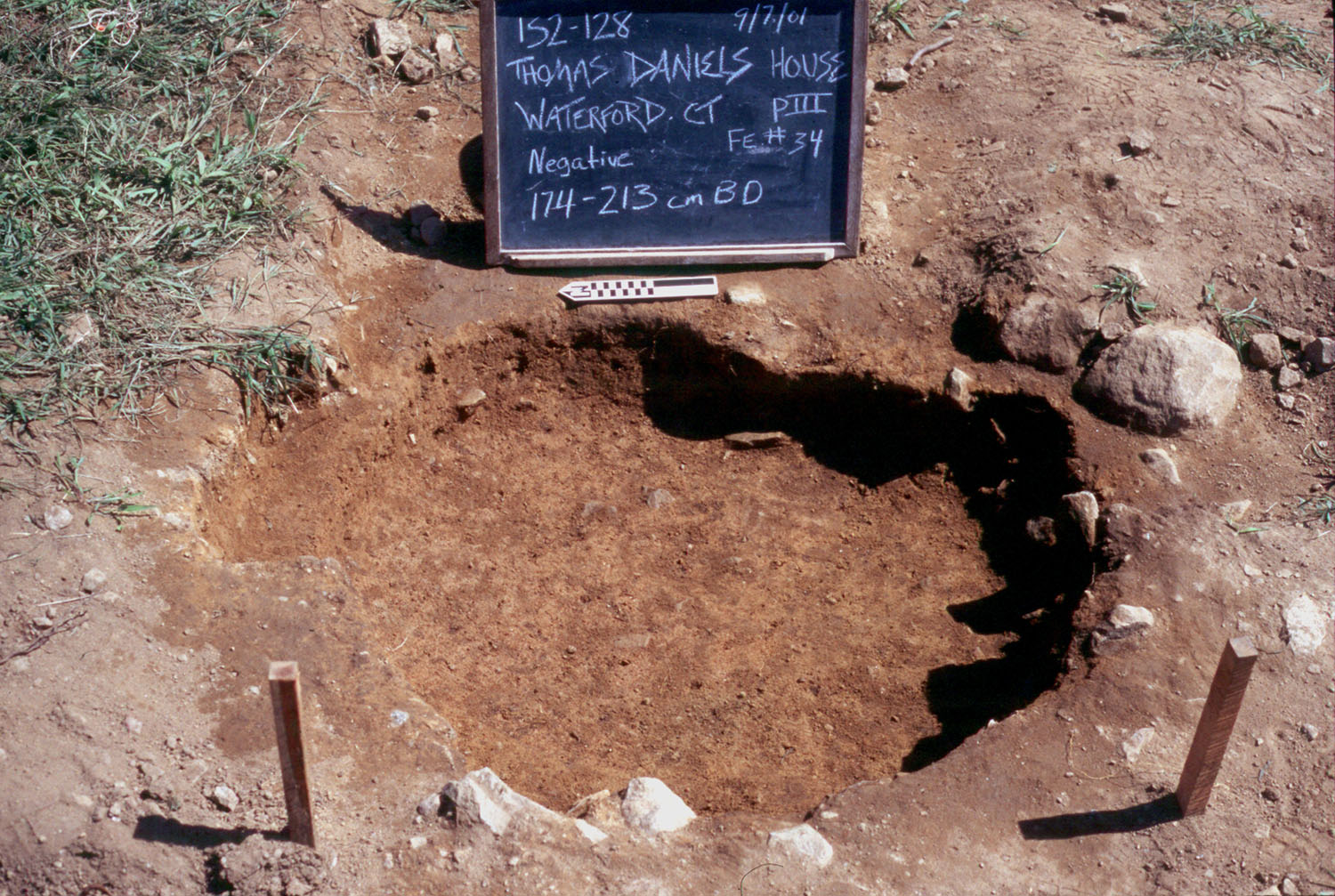
|
|
A sauce pit feature found 23 feet south of the cellar. Such basin-shaped holes were used to store root vegetables or “sauce,” as they were called in the 18th century. Click to enlarge. |
Barrels of salted beef, salted pork, cider and other foods were stored in cellars, which kept the food from freezing in the winter and cool in the summer. One other method used to store root vegetables or “sauce,” as it was called in 18th-century Connecticut, was with food storage pits or “sauce pits” dug in the ground. These pits were typically two to four feet in diameter, several feet deep and basin-shaped. The bottom of the sauce pits were lined with boards or straw and then the root vegetables, such as potatoes, were laid inside with straw. The hole was then covered with a thick mound of manure or salt hay, if one lived near the sea, for insulation. Three such sauce pits were found outside of the Daniels House. After the root vegetables were removed from the pit, the holes were typically filled with household refuse. The subfloor pit in the post-in-ground addition may also have functioned as a sauce pit. Grains such as corn, beans, barley, oats and wheat were commonly stored high and dry in the upper part of the house called the garret, or in a specially-made crib.
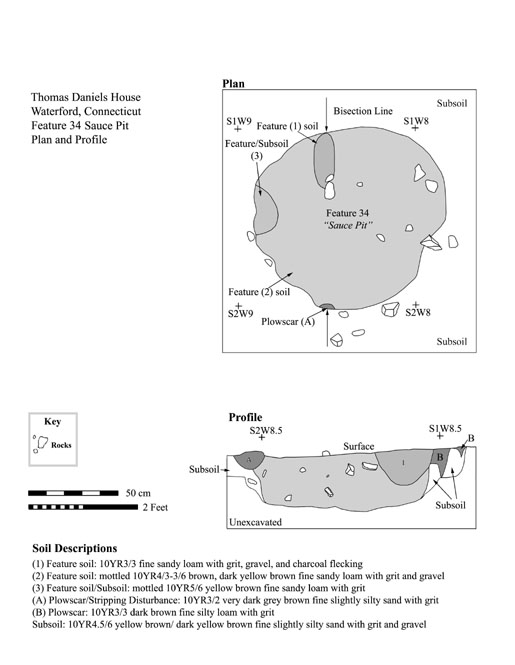
|
|
Plan and profile of sauce pit. Click to enlarge. |